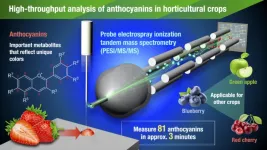(Press-News.org) *Note: this is a joint press release from the European Congress of Clinical Microbiology & Infectious Diseases (ECCMID) and The Lancet. Please credit both the congress and the journal in your stories*
A new study to be presented at this year’s European Congress of Clinical Microbiology & Infectious Diseases (ECCMID 2023, Copenhagen 15-18 April), and published in The Lancet, shows that, compared with standard care that included low dose corticosteroid use, treating hypoxic COVID-19 patients needing only oxygen therapy or no breathing support with higher dose corticosteroids is associated with a 60% increased risk of death.
This study conducted by the RECOVERY Collaborative Group and led by Prof Sir Peter Horby and Prof Sir Martin Landray (both of the University of Oxford, UK) had already identified that low-dose corticosteroids reduce mortality for patients with COVID-19 requiring oxygen or ventilatory support. Since May 2021, the RECOVERY trial has evaluated the use of a higher dose of corticosteroids in this patient group. However, in May 2022, the independent Data Monitoring Committee advised that this treatment assessment be stopped for those patients receiving oxygen alone or no breathing support. The trial continues to study the effects of high-dose corticosteroids for those needing non-invasive or invasive mechanical ventilation.
Eligible and consenting adult patients with COVID-19 and clinical evidence of hypoxia (ie, receiving oxygen or with oxygen saturation <92% in normal room air) were randomly allocated (1:1) to either usual care with higher dose corticosteroids (dexamethasone 20 mg once daily for 5 days followed by 10 mg dexamethasone once daily for 5 days or until discharge if sooner) or usual standard of care alone (which included dexamethasone at the lower 6 mg once daily dose for 10 days or until discharge if sooner). The primary outcome was 28-day mortality among all randomised participants.
Between May 25, 2021, and May 13, 2022, 1272 patients with COVID-19 and hypoxia receiving no oxygen (eight [1%]) or simple oxygen only (1264 [99%]) were randomly allocated to receive usual care plus higher dose corticosteroids (659 patients) versus usual care alone (613 patients, of whom 87% received low-dose corticosteroids during the follow-up period). Of those randomly assigned, 745 (59%) were in Asia, 512 (40%) in the UK, and 15 (1%) in Africa. 248 (19%) had diabetes and 769 (60%) were male. Overall, 123 (19%) of 659 patients allocated to higher dose corticosteroids versus 75 (12%) of 613 patients allocated to usual care died within 28 days – meaning a 60% increased risk of mortality for the higher dose corticosteroid group.
There was also an excess of pneumonia reported to be due to non-COVID infection in the higher-dose corticosteroid group: 64 cases (10%) vs 37 cases (6%); and an increase in hyperglycaemia (high blood sugar episode) requiring an increased insulin dose: 142 [22%] vs 87 [14%].
The authors conclude: “Among hospitalised patients with COVID-19 who require oxygen or ventilatory support, low-dose corticosteroids reduce the risk of death. However, among patients requiring simple oxygen only, higher doses of corticosteroids increase the risk of death compared with low-dose corticosteroids. It remains unclear whether using a higher dose of corticosteroids is beneficial among patients requiring non-invasive or invasive ventilation—the RECOVERY trial continues to study this.”
Professor Sir Peter Horby, Professor of Emerging Infections and Global Health at the University of Oxford and the Director of the Pandemic Sciences Institute, University of Oxford, UK. E) peter.horby@ndm.ox.ac.uk
Professor Sir Martin Landray, Professor of Medicine and Epidemiology, Oxford Population Health, University of Oxford, UK. E) martin.landray@ndph.ox.ac.uk
For further information or interview requests with the chief investigators, please contact Louise Phillips, Communications Officer, Oxford Population Health T) +44 (0)1865 617 824 E) Louise.Phillips@ndph.ox.ac.uk
Alternative contact Tony Kirby in the ECCMID Media Centre. T) +44 7834 385827 E) tony@tonykirby.com
Full details of the study protocol and related materials are available at www.recoverytrial.net.
The RECOVERY trial is conducted by Oxford Population Health’s registered clinical trials units in partnership with the Nuffield Department of Medicine. The trial is supported by a grant to the University of Oxford from UK Research and Innovation/ the National Institute for Health Research (NIHR), and by core funding provided by the Bill and Melinda Gates Foundation, the Foreign, Commonwealth & Development Office, Health Data Research UK, the Medical Research Council Population Health Research Unit, the NIHR Oxford Biomedical Research Centre, NIHR Clinical Trials Unit Support Funding, and Wellcome. Funding for RECOVERY outside the UK is provided by Wellcome through the COVID-19 Therapeutics Accelerator.
The RECOVERY trial currently involves many thousands of doctors, nurses, pharmacists, and research administrators at 178 hospitals across the whole of the UK. In the UK, the trial is supported by staff at the NIHR Clinical Research Network, NHS DigiTrials, Public Health England, Department of Health & Social Care, the Intensive Care National Audit & Research Centre, Public Health Scotland, the Secure Anonymised Information Linkage at the University of Swansea, and the NHS in England, Scotland, Wales and Northern Ireland.
END
Higher dose corticosteroids associated with a 60% increased risk of death in hypoxic COVID-19 patients requiring only non-invasive oxygen therapy (The Lancet / RECOVERY trial)
2023-04-13
ELSE PRESS RELEASES FROM THIS DATE:
Assisted reproduction kids grow up just fine – but it may be better to tell them early about biological origins, twenty-year study suggests
2023-04-13
Paper available at: https://drive.google.com/drive/folders/1y9GfgYkRdUtwyq6nBhySePTUHZYP6iAj?usp=share_link
Landmark study finds no difference in psychological wellbeing or quality of family relationships between children born by assisted reproduction (egg or sperm donation or surrogacy) and those born naturally at age 20.
However, findings suggest that telling children about their biological origins early – before they start school – can be advantageous for family relationships and healthy adjustment.
The study, by University of Cambridge researchers, is the first to examine the long-term ...
The hidden culprit behind nitrogen dioxide emissions
2023-04-13
Nitrogen dioxide is one of the criteria air pollutants that plays an important role as a precursor gas of fine particulate matter and ozone. NO2 emissions are known to be primarily generated by industrial facilities or vehicle exhausts. Recently, a research team from POSTECH analyzed satellite remote sensing data from the European Space Agency (ESA) and released results showing that food processing facilities and high-rise apartments that are 10 stories or higher are significant sources of NO2 emissions. Their findings have drawn attention from NASA.
A ...
Notable birth cohort effects on the incidence trend of renal replacement therapy in Japan
2023-04-13
Niigata, Japan - A new Japanese study reveals significant birth cohort effects on the incidence trend of ESKD requiring RRT.
“Different birth cohorts may have different levels of exposure to a particular risk factor, which may produce a change in disease incidence for individuals born at a particular time, i.e. a cohort effect,” said Dr. Wakasugi, the corresponding author of the study. “Age-Period-Cohort (APC) analysis, a statistical method to distinguish between age, period, and ...
Time out: We all need a three-day weekend
2023-04-13
As a four-day work week is trialled in countries across the globe, health researchers at the University of South Australia say they’re ‘all in’ when it comes to a long weekend, especially as new empirical research shows that the extra time off is good for our health.
Assessing changes in daily movements before, during and after holidays, researchers found that people displayed more active, healthy behaviours when they were on holiday, even when they only had a three-day break.
Across the 13-month study period, people generally took an average two to three holidays, each being around 12 days. The most common holiday type was ‘outdoor ...
Using a new technique, PESI/MS/MS, to analyze the nutritional compounds in crops
2023-04-13
Anthocyanins are compounds related to the color of plants. They also have beneficial effects on human health and are used as a supplement. Various species of anthocyanins, divided by their molecular shape, are present in plants. Therefore, simple, and rapid, analytical techniques that can distinguish among these species in crops are necessary for breeding and quality assessment. A team of Nagoya University researchers in Japan has used a technique called probe electrospray ionization tandem mass spectrometry (PESI/MS/MS) to analyze anthocyanins in crops. ...
HKU biologists determine the evolutionary age of individual cell types providing critical insights for animal development
2023-04-13
A research team led by Dr Chaogu ZHENG from the School of Biological Sciences at The University of Hong Kong (HKU) has recently made a significant discovery about the evolutionary age of different type of cells in a small animal called Caenorhabditis elegans (C. elegans). By using single-cell transcriptomic data and refined phylostratigraphy, the team determines the transcriptomic age of individual cells, which means they are able to estimate the evolutionary origin of different cells based on the age of the genes expressed in the ...
Coral-eating fish poo may act as ‘probiotics’ for reefs
2023-04-13
Until recently, fish that eat coral — corallivores — were thought to weaken reef structures, while fish that consume algae and detritus — grazers — were thought to keep reefs healthy. But scientists have discovered that feces from grazers leave large lesions on coral, possibly because they contain coral pathogens. By contrast, feces from corallivores may provide a source of beneficial microbes that help coral thrive.
“Corallivorous fish are generally regarded as harmful because they bite the corals,” said Dr Carsten Grupstra of Rice University, ...
New study demonstrates hospital safety climate and organizational characteristics predict healthcare-associated infections and occupational health outcomes
2023-04-13
Arlington, Va., April 13, 2023 – New data published today in the American Journal of Infection Control (AJIC) provide the first published evidence that a positive safety climate and adherence to standard precautions predict key healthcare-associated infection (HAI) and occupational health outcomes among patients and health care workers, respectively. The findings highlight features within hospitals’ organizations and safety climates that could be modified to improve these outcomes.
“Despite the infection prevention and safety benefits associated with standard precautions, generating consistent adherence in the healthcare setting has been ...
Selenium as a predictor of metabolic syndrome in middle age women
2023-04-12
“Recently, optimizing selenium intake in the population to prevent diseases [...] has been an important issue in modern health care worldwide.”
BUFFALO, NY- April 12, 2023 – A new research paper was published in Aging (listed by MEDLINE/PubMed as "Aging (Albany NY)" and "Aging-US" by Web of Science) Volume 15, Issue 6, entitled, “Selenium as a predictor of metabolic syndrome in middle age women.”
Metabolic syndrome (MetS) is a widespread clinical entity that has become almost a global epidemic. Selenium plays an important role in metabolic homeostasis. It has been suggested that it ...
A new vision for soybean meal: designer tempeh
2023-04-12
In a novel effort to create the next generation of plant-based, protein-rich environmentally sustainable and savory alternatives to animal meat, a University of Massachusetts Amherst food scientist has turned his attention to soybean meal.
Globally, this byproduct of soybean oil extraction is used almost exclusively for animal feed. In the U.S. alone, some 48 million metric tons of soybean meal was produced in 2022, according to the USDA.
“After the oil extraction, the majority of the protein is in the meal, not the oil,” says Hang ...






